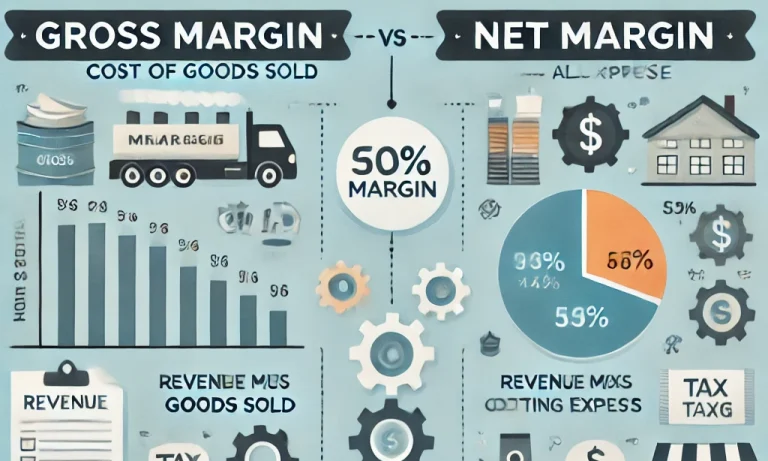Gross margin and net margin are two types of profitability ratios relating to a company’s financial health and serve as key points to measure when analyzing either investments or business performance. While both relate to different sides of a company’s profitability, gross margin focuses on the revenue generated by a company when the direct costs of producing goods and services are subtracted. On the other hand, net margin reflects the general profitability of a business after all expenses, including operating costs, interest, taxes, and other non-operational expenses, have been considered.
Understanding the difference between Gross Margin and Net Margin is very important to analyze a company’s efficiency at its different levels of cost management and how well it converts revenue into profit. Gross margin helps to understand production efficiency, while net margin is even more sensitive as it captures the overall financial health and profitability of the company.
Gross Margin vs Net Margin: Key Differences
The main difference between gross margin and net margin is the types of costs deducted from revenue. Gross margin would deduct direct costs of goods or services, such as raw materials, labor, and manufacturing costs. On the other hand, net margin includes any business expenses, including fixed costs like rent and salaries, variable costs, taxes, interest, and others.
In a nutshell, gross margin provides a picture of how well a firm can manufacture and sell its goods or services. Net margin, by contrast, reflects how well the company operates all its costs – direct and indirect, and how much profit is left after taking all the latter into account.
| Aspect | Gross Margin | Net Margin |
|---|---|---|
| Definition | Measures profitability after direct production costs. | Measures overall profitability after all expenses. |
| Costs Deducted | Only direct costs of production or services. | All costs, including operating, interest, taxes, and depreciation. |
| Focus | Efficiency in production and pricing. | Overall financial performance and management. |
| Calculation | (Revenue – Cost of Goods Sold) / Revenue x 100 | (Net Income / Revenue) x 100 |
| Usefulness | Useful for understanding core business operations. | Provides insight into a company’s overall profitability. |
| Who Uses It? | Analysts, production managers, and pricing teams. | Investors, financial analysts, and business owners. |
| Timeframe | Typically used on a per-product or per-service basis. | Used for overall financial performance on a company-wide basis. |
Gross margin and net margin help spot the company’s strengths and weaknesses in its operations. Gross margin can identify problems of low efficiency in production, while net margin may be more representative of a company’s overall financial condition by including cost control, including management practices that are observed across the entire business.
What is Gross Profit Margin?
Gross profit margin is one of the more important financial metrics, which enables a company to express the percentage of revenue that is retained after subtracting direct costs for the production of goods or services. These costs are usually called the cost of goods sold (COGS). Gross profit margin helps determine how efficiently a company uses resources in the production process.
Gross profit margin is the basic profitability of any company’s core business operations before deducting overhead costs, including salaries, rent, and marketing. The marginal indicates how well a company can create a rough margin to go on and make its revenue from direct costs such as labor, materials, and manufacturing expenses.
Hence, a higher gross margin indicates that a company has more leftovers after subtracting direct costs in terms of production, which could mean pricing power or efficient production processes. Low gross margins may be indications of inefficiencies in production, high raw material costs, or trouble in pricing products appropriately.
Gross Profit Margin Formula
To calculate the gross profit margin, the formula is as follows:

How to Calculate Gross Margin?
Calculating gross margin is easy and requires a very simple formula. Knowing this calculation can help business owners and analysts better understand the production process efficiency of their company. Here is how you can do it:
Step-by-Step Calculation
- Identify Revenue: Revenue is the total amount of money generated by the sale of goods or services.
- Determine Cost of Goods Sold (COGS): COGS includes all direct costs related to the production of goods, such as raw materials, labor, and manufacturing expenses.
- Subtract COGS from Revenue: This gives the gross profit.
- Divide Gross Profit by Revenue: The result will be the gross margin percentage.
For instance, if a business generates $500,000 in revenue and has $200,000 in COGS, the gross margin would be:

Example Calculation
Imagine a company that sells 10,000 units of a product, each priced at $20. The total revenue will be:
Revenue=10,000×20=200,000
Now, if the COGS is $80,000, the gross margin will be:

A 60% gross margin means that the company retains 60 cents for every dollar in revenue after covering its production costs.
What is Net Profit Margin?
Compared to the gross margin, the net profit margin is a more complete measure of profitability. In other words, it represents the percentage of revenue left as a profit after all expenses have been taken into account. This involves not only the cost of goods sold (COGS) but also all forms of operating costs, interest, taxes, and depreciation, among other non-operational costs.
An important indicator of the general financial health of a company would be the net profit margin. Compared to gross margin, net margin accounts for the company’s entire operations, thereby making it clearer in terms of what constitutes its costs. Gross margin focuses purely on the direct costs of producing something.
Net profit margin is very helpful in identifying whether the company effectively controls its operating expenses and generates profits after costs are subtracted. A higher net margin usually implies that a company can convert revenue into actual profit more efficiently, while a poor net margin usually means that a company may incur higher operating costs, run non-technological processes, or be less effective in generating revenue.
Net Profit Margin Formula
To calculate the net profit margin, the formula is:

Where:
- Net Income: The total profit after deducting all expenses, including COGS, operating expenses, interest, and taxes.
- Revenue: The total sales or income generated by the company.
How to Calculate Net Margin?
To calculate the net margin, you will need net income and total revenue. Net income refers to that which remains from total revenue after deducting all and any operating costs, taxes, interest, and other expenses.
Step-by-Step Process for Calculating Net Margin:
- Find Net Income: This is the final profit after deducting all costs, including operating expenses, taxes, and interest.
- Identify Total Revenue: This is the gross income generated from sales.
- Divide Net Income by Revenue: This gives the net margin percentage.
- Multiply by 100: This converts the result into a percentage.
Example:
- Revenue: $1,000,000
- Net Income: $100,000
- Net Margin: ($100,000 / $1,000,000) * 100 = 10%
This calculation shows that after all expenses, the company retains 10% of its revenue as profit.
How to Interpret Gross Margin and Net Margin?
Gross and net margins should be understood to interpret how the business is performing. Each of the margins captures different aspects of financial performance and profitability by the company.
- Gross margin interpretation: If the gross margin turns out to be high, it means the company can generate significant revenues from its main operations with relatively low direct costs. It usually indicates efficient production or strong pricing power. A low gross margin could indicate high production costs, poor pricing, or manufacturing process inefficiencies.
- Net Margin: More Comprehensive Source of Information about a Company’s Profitability. A high net margin of a company is indicative of efficiency not only in managing the direct cost of production, but also the operating expenses, interest payments, and taxes. Conversely, a low net margin may be an indicator that the company is not managing its overall expenses well or may not be in a position to convert earnings into a profit.
Gross Margin and Net Margin FAQs
What is the primary difference between gross margin and net margin?
The primary difference is that gross margin measures the efficiency of a company’s core production processes, while net margin considers all expenses, including taxes and interest, to determine overall profitability.
Why is gross margin important for businesses?
Gross margin is important because it shows how efficiently a company can produce its products or services. A high gross margin indicates strong cost management at the production level.
How does net margin affect a company’s profitability?
Net margin reflects the company’s ability to manage all costs, including operating expenses, interest, and taxes. A higher net margin indicates better overall profitability and financial health.
What factors can affect gross margin?
Factors that affect gross margin include production costs, pricing strategies, economies of scale, and supply chain efficiency.
Can a company have a high gross margin but low net margin?
Yes, a company can have a high gross margin but low net margin if it has high operating expenses, interest costs, or tax burdens that reduce its net income.


